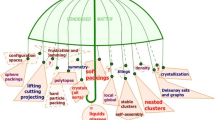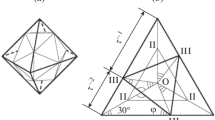Abstract
Optimal geometrical arrangements, such as the stacking of atoms, are of relevance in diverse disciplines1,2,3,4,5. A classic problem is the determination of the optimal arrangement of spheres in three dimensions in order to achieve the highest packing fraction; only recently has it been proved1,2 that the answer for infinite systems is a face-centred-cubic lattice. This simply stated problem has had a profound impact in many areas3,4,5, ranging from the crystallization and melting of atomic systems, to optimal packing of objects and the sub-division of space. Here we study an analogous problem—that of determining the optimal shapes of closely packed compact strings. This problem is a mathematical idealization of situations commonly encountered in biology, chemistry and physics, involving the optimal structure of folded polymeric chains. We find that, in cases where boundary effects6 are not dominant, helices with a particular pitch-radius ratio are selected. Interestingly, the same geometry is observed in helices in naturally occurring proteins.



Similar content being viewed by others
References
Sloane, N. J. A. Kepler's conjecture confirmed. Nature 395, 435–436 (1998).
Mackenzie, D. Mathematics—proving the perfection of the honeycomb. Science 285, 1339–1340 ( 1999).
Woodcock, L. V. Entropy difference between the face-centred cubic and the hexagonal close-packed crystal structures. Nature 385, 141– 143 (1997).
Car, R. Crystal structure—how hard spheres stack up. Nature 385 , 115–116 (1997).
Cipra, B. Mathematics—packing challenge mastered at last. Science 281, 1267 (1998).
Stewart, I. Tight tins for round sardines. Sci. Am. Feb. 80– 82 (1998).
Buck, G. & Orloff, J. A simple energy function for knots. Topol. Appl. 61, 205–214 (1995).
Katritch, V. et al. Geometry and physics of knots. Nature 384, 142–145 (1996).
Katritch, V., Olson, W. K., Pieranski, P., Dubochet, J. & Stasiak, A. Properties of ideal composite knots. Nature 388, 148–151 (1997).
Gonzalez, O. & Maddocks, J. H. Global curvature, thickness and the ideal shapes of knots. Proc. Natl Acad. Sci. USA 96, 4769–4773 (1999).
Buck, G. Four thirds power law for knots and links. Nature 392 , 238–239 (1998).
Cantarella, J., Kusner, R. B. & Sullivan, J. M. Tight knot values deviate from linear relations. Nature 392, 237–238 (1998).
Rose, G. D. & Seltzer, J. P. A new algorithm for finding the peptide chain turns in a globular protein. J. Mol. Biol. 113, 153–164 (1977).
Micheletti, C., Maritan, A. & Banavar, J. R. Protein structures and optimal folding from a geometrical variational principle. Phys. Rev. Lett. 82, 3372–3375 (1999).
Maritan, A., Micheletti, C. & Banavar, J. R. Role of secondary motifs in fast folding polymers: a dynamical variational principle. Phys. Rev. Lett. 84, 3009–3012 (2000).
Sali, A., Shakhnovich, E. & Karplus, M. How does a protein fold? Nature 369, 248–251 (1994).
Creighton, T. E. Proteins—Structures and Molecular Properties 182– 188 (Freeman, New York, 1993).
Yee, D. P., Chan, H. S., Havel, T. F. & Dill, K. A. Does compactness induce secondary structure in proteins? Study of poly-alanine chains computed by distance geometry. J. Mol. Biol. 241, 557–573 (1994).
Socci, N. D., Bialek, W. S. & Onuchic, J. N. Properties and origins of protein secondary structure. Phys. Rev. 49, 3440–3443 (1994).
Sokal, A. D. Monte Carlo methods for the self-avoiding walk. Nucl. Phys. B47, 172–179 (1996).
Acknowledgements
This work was supported by INFN, NASA and The Donors of the Petroleum Research Fund administered by the American Chemical Society. A.T. thanks the Physics Department of Università degli Studi di Padova, Padova, Italy, for its hospitality.
Author information
Authors and Affiliations
Rights and permissions
About this article
Cite this article
Maritan, A., Micheletti, C., Trovato, A. et al. Optimal shapes of compact strings. Nature 406, 287–290 (2000). https://doi.org/10.1038/35018538
Issue Date:
DOI: https://doi.org/10.1038/35018538
- Springer Nature Limited
This article is cited by
-
Trade-offs and design principles in the spatial organization of catalytic particles
Nature Physics (2022)
-
Theoretical analysis on thermodynamic stability of chignolin
Scientific Reports (2019)
-
The role of directional interactions in the designability of generalized heteropolymers
Scientific Reports (2017)
-
Shapes of minimal-energy DNA ropes condensed in confinement
Scientific Reports (2016)
-
Subknots in ideal knots, random knots and knotted proteins
Scientific Reports (2015)





